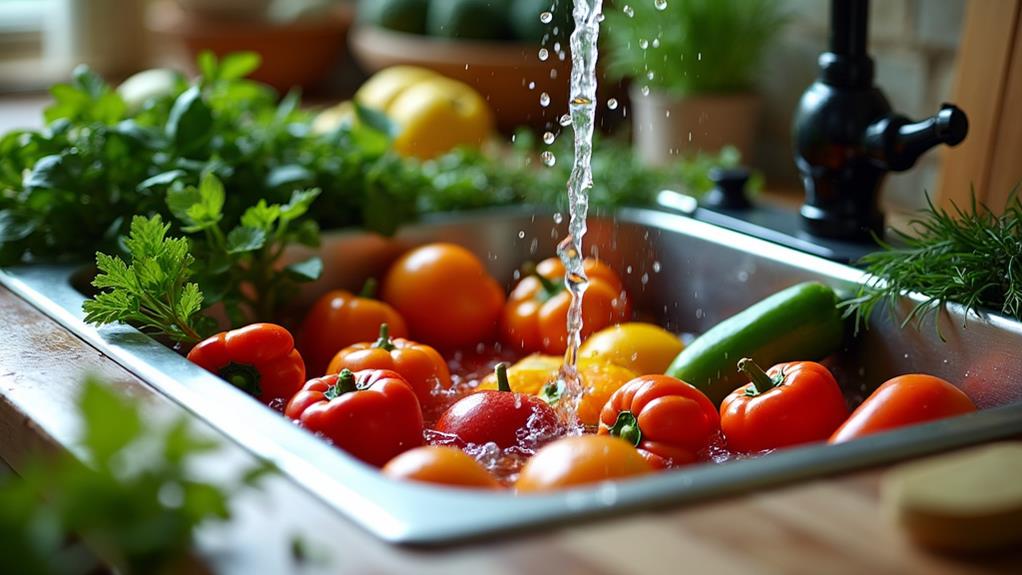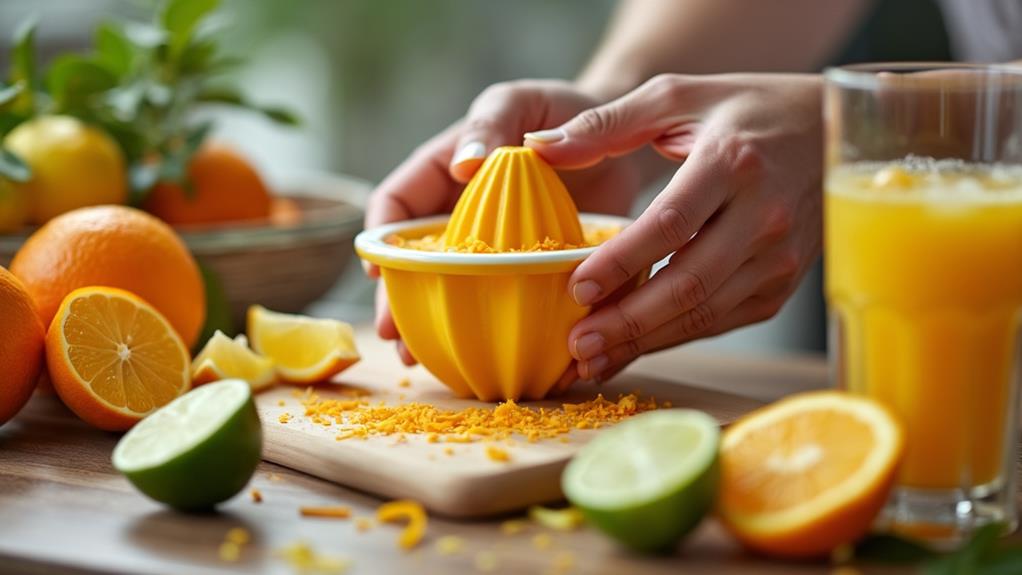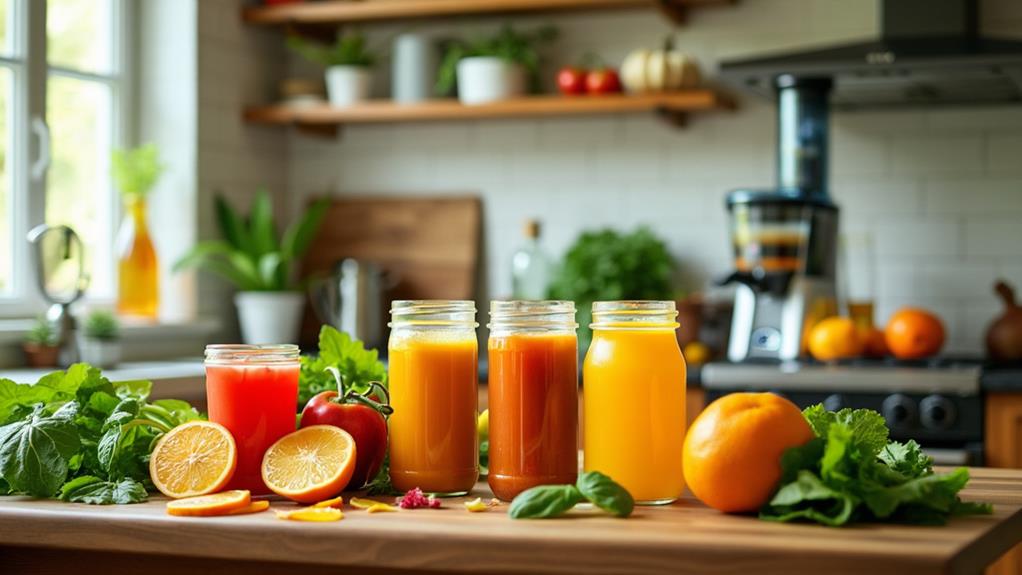How to Identify Fresh Fruits and Vegetables
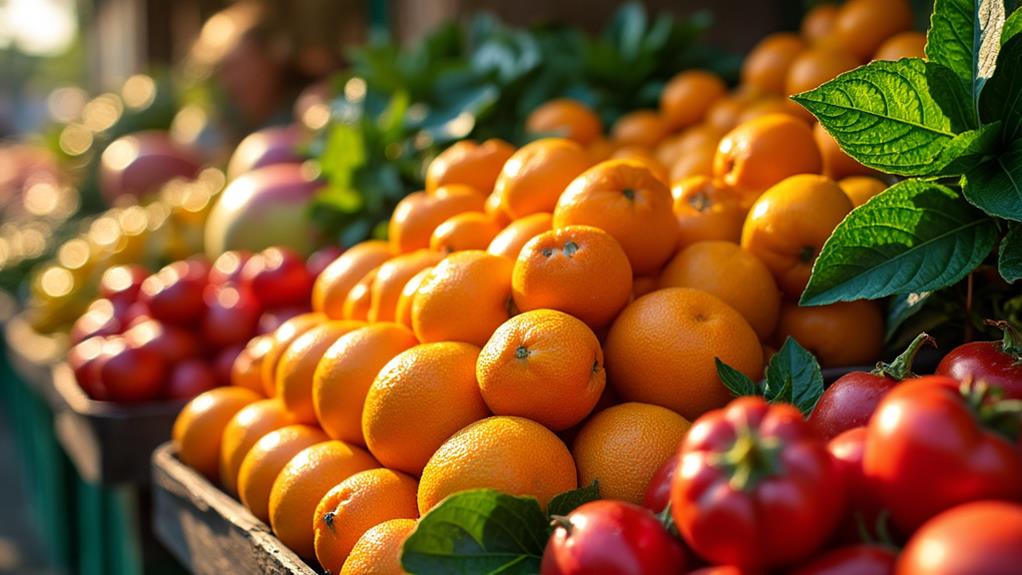
To identify fresh fruits and vegetables, look for lively colors and firm textures. Firm veggies like bell peppers should have shiny, unwrinkled skins. Avoid soft spots in tomatoes and cucumbers; these should feel firm to the touch. Fresh fruits will emit sweet scents; pungent odors suggest spoilage. Bright-colored leafy greens are preferable to yellowing or wilted ones. Check root vegetables for heavy weight and dry, unbroken skin to verify ripeness. Sourcing produce locally or seasonally often assures freshness and richer flavors. Accept these simple methods to bring the best ingredients to your table while exploring new buying tips.
Visual Cues for Freshness
When you're selecting fresh fruits and vegetables, visual cues are your best guide. Start by observing the lively colors of the produce. Fresh fruits and vegetables should display rich, bright hues; dull or faded colors might suggest overripeness or spoilage. Check for firmness as a critical visual indicator, especially in vegetables like bell peppers. They should have shiny, taut skin without any wrinkles or soft spots, guaranteeing their freshness.
Examine the skin of fruits like tomatoes and apples. Look for smooth, unblemished skin, as any bruising or discoloration can indicate damage and reduced quality. This is a crucial step to ascertain you're getting the best produce. Leafy greens should exhibit deep, lively colors. Avoid those with yellowing leaves or signs of wilting, since these are clear indicators of aging.
For root vegetables such as carrots and potatoes, opt for those with dry, unbroken skin. Avoid any that show signs of sprouting or have excessive blemishes, as these suggest they're past their prime. By relying on these visual indicators—lively colors, firmness, and unblemished skin—you'll confidently pick the freshest produce.
Touch and Texture Indicators
Beyond just looking at the produce, getting hands-on with fruits and vegetables offers another layer of assessment. Touch and texture indicators are essential for guaranteeing you're selecting the freshest options. When checking for firmness, press gently on the produce. Fresh fruits and vegetables should yield slightly to your touch, indicating they're ripe but not overripe.
For avocados, you'll want them to have a slight give when you press them. If they're mushy, they may be spoiled. Tomatoes, on the other hand, should feel slightly firm. Be on the lookout for any soft spots, as these can signal decay and compromise their quality. Cucumbers should be crisp and firm too; if you find any soft spots, they might be past their prime, affecting both flavor and texture.
When it comes to bell peppers, they should feel firm with smooth, unwrinkled skin. Softness or shriveling indicates they're aging and might lack that fresh taste you're after. By honing your touch and texture skills, you'll guarantee that you pick only the freshest vegetables and fruits, keeping your meals lively and full of flavor.
Aromatic Signs of Ripeness
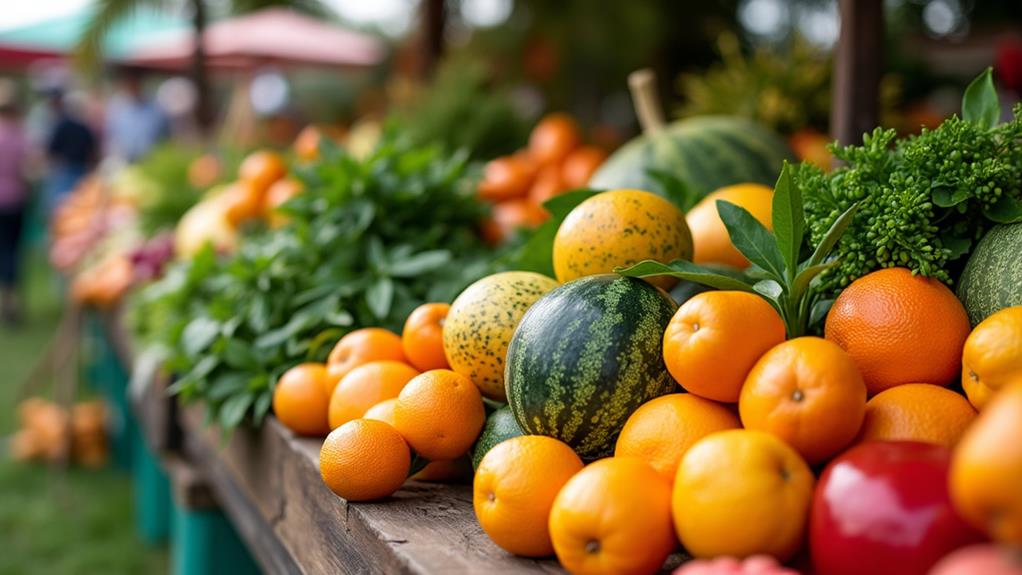
In the quest for the freshest produce, don't underestimate the power of your nose. Aromatic signs can be a reliable indicator of freshness and ripeness. Fresh fruits and vegetables often emit a sweet or fragrant aroma when they're perfectly ripe. If you notice a pleasant smell, that's a good sign you've found something fresh. On the other hand, if a fruit or vegetable lacks scent, it may still be under-ripe and not yet ready to eat.
Citrus fruits are a great example. When you gently squeeze them, they should release a zesty fragrance. If there's no aroma, it might mean they're not ripe. Likewise, ripe tomatoes should have a strong, sweet smell near the stem. Be cautious of any off-putting odors, as they can indicate overripeness or spoilage.
For fresh herbs, a strong, pleasant smell is key. If they lack aroma or look wilting, they're probably past their prime. As for avocados, a slight, pleasant fragrance is what you're looking for. If it doesn't give off any scent, it's likely still unripe. Trust your nose to guide you in selecting the freshest produce.
Seasonal Buying Tips
Embracing seasonal buying tips can improve your produce selection by guaranteeing you get the freshest, most flavorful fruits and vegetables. When you choose seasonal fruits and vegetables, you're not just selecting items at their peak ripeness; you're also maximizing their nutritional value. These items are harvested at the right time, offering superior taste and texture. Plus, seasonal produce is often more affordable, making it easier to plan delicious, budget-friendly meals.
By opting for locally grown produce, you support local farmers and reduce the environmental impact linked to long-distance transportation. This choice promotes sustainability and strengthens your community. Familiarize yourself with regional seasonal produce calendars to make informed shopping decisions and find new varieties to incorporate into your diet.
Consider these tips for making the most of seasonal buying:
- Plan meals around what's in season to verify you're using fresh produce.
- Visit farmers' markets for locally grown options that are fresher and more eco-friendly.
- Stay informed about seasonal availability to enjoy the best taste and nutritional value.
- Experiment with recipes featuring in-season ingredients to diversify your meals.
- Watch for sales on seasonal items to save money while buying quality produce.
Local vs. Imported Produce
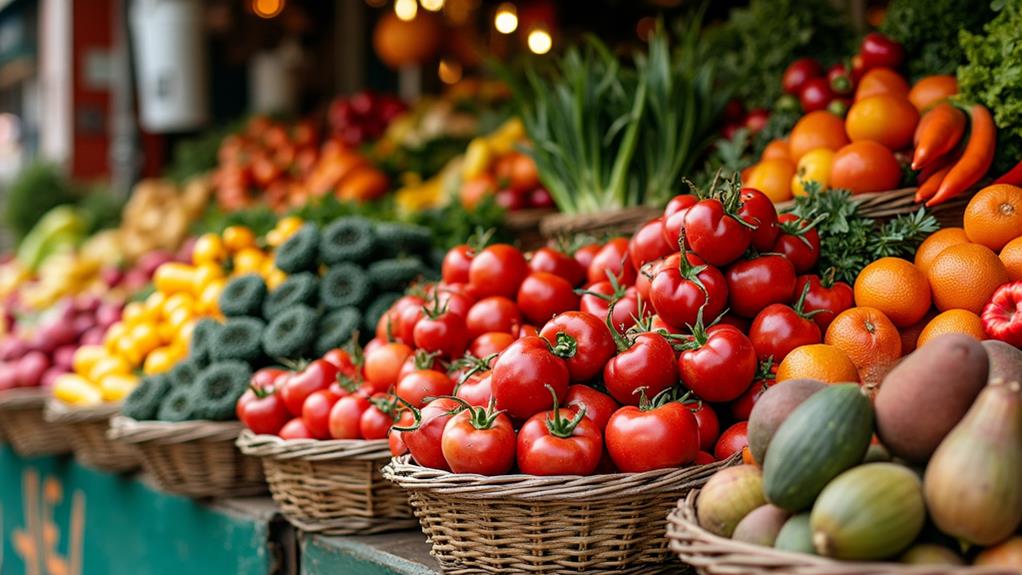
You might wonder if you should choose local or imported produce during your next grocery run. Going local often means you're getting fruits and vegetables harvested at their peak ripeness, ensuring the freshest flavors. Unlike imported produce, which is picked early for long-distance transport, local options are more likely to retain their natural taste and texture. Seasonal local produce is also typically more nutrient-dense since it doesn't lose vitamins and minerals during lengthy shipping times.
Supporting local farmers by buying their produce not only enhances the community but also reduces the carbon footprint linked to food transportation. This eco-friendly choice helps in maintaining a more sustainable environment. Furthermore, local fruits and vegetables often have fewer chemical treatments compared to imported ones. This means you'll likely encounter fewer additives and a higher chance of finding organic options.
Farmers markets and local grocery stores frequently offer a wider variety of seasonal produce, allowing you to enjoy the freshest ingredients available. By opting for local, you're making a choice that benefits your health, your community, and the planet. Next time you're shopping, consider the advantages of going local for fresh, flavorful produce.
Choosing Fresh Fruits
Choosing fresh fruits can improve your meals and snacks, providing lively flavors and essential nutrients. When you're at the market, you must know how to select the best from what the produce is delivered. Start by observing the fruit's color; bright hues typically indicate freshness. Avoid fruits showing any signs of dullness or discoloration, as they might be overripe or spoiled.
To guarantee you're picking the freshest fruits, follow these tips:
- Feel Firm: Gently squeeze the fruit. It should be firm but have a slight give, indicating ripeness without being overly soft.
- Smell It: A sweet, pleasant aroma often signals ripeness, while an overpowering smell can suggest it's past its prime.
- Inspect the Skin: Look for any blemishes, bruises, or wrinkles. These imperfections, especially on fruits like tomatoes and peaches, can mean quicker spoilage.
- Check for Any Signs: For bananas, choose those with yellow skin and brown speckles; apples should be free of bruises.
- Assess Freshness: Use your senses to gauge the fruit's condition. Fresh produce is a delight to the senses and will improve your culinary creations.
Selecting Quality Vegetables
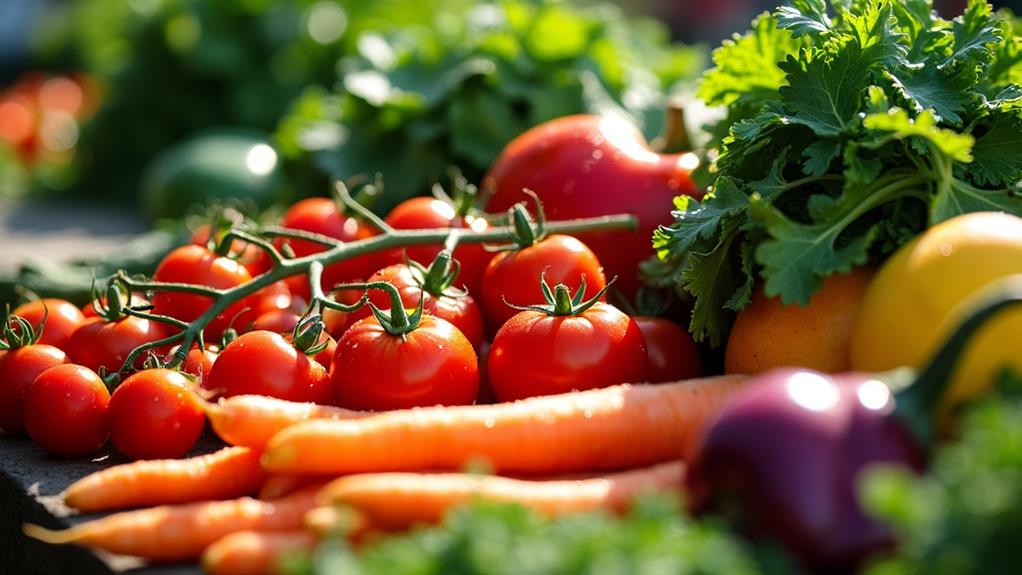
While picking out fresh fruits adds lively flavors to your meals, selecting quality vegetables is just as significant for maintaining a balanced diet. When you're buying fresh veggies, always prioritize those with brilliant colors and firm textures. These are key indicators of freshness and ripeness, guaranteeing that you're getting the best quality. For bell peppers, look for shiny, unwrinkled skin and a green stem—these suggest they're fresh and not on the verge of rotting.
When you select fresh cucumbers, confirm they feel firm with a consistent color. Avoid any cucumbers with soft spots or wrinkled skin, as these signs indicate overripeness. For leafy greens, focus on deep green leaves without any wilting or yellowing. These characteristics mean the greens are fresh, offering ideal nutritional benefits.
If you're buying corn, feel the weight and check the husks. Fresh corn should feel heavy with moist, pale green husks. The kernels should be plump and release a milky substance when you press them, a clear sign of freshness. By knowing what to look for when buying, you can easily select fresh veggies that improve your meals.
Benefits of Fresh Produce
Fresh produce isn't just a delight for the taste buds; it's a powerhouse of vital nutrients significant for maintaining good health. When you include fresh fruits and vegetables in your diet, you're giving your body fundamental vitamins, minerals, and antioxidants that help reduce the risk of chronic diseases. Fresh produce retains higher levels of vitamins, particularly vitamin C, compared to food that's been stored for longer periods. This retention optimizes nutritional value, supporting your comprehensive health and well-being.
Incorporating fresh produce into your meals also aids in weight management, thanks to its low calorie and high fiber content. These foods help you feel full longer, promoting satiety and improving digestive health. Additionally, fresh fruits and vegetables can elevate your mood and mental well-being. Studies show a positive correlation between increased intake of these foods and improved mental health outcomes.
Consider purchasing locally grown produce during your grocery shopping trips. Not only do seasonal and locally sourced options taste better, but they also support local economies and reduce environmental impacts.
- Rich in fundamental nutrients
- Retains high vitamin C levels
- Supports weight management
- Elevates mood and mental health
- Benefits local economies and environment


